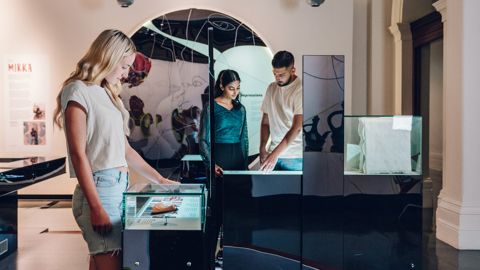What are the Federation Handbells?
The Federation Handbells are uniquely crafted and innovative musical instruments that celebrate the power of bells to call people together. The Handbells were commissioned by the Victorian Government with the Melbourne International Arts Festival for the 2001 Centenary of Federation.
They can be used by players of all skill levels for any occasion or musical style, and are available for loan to everyone.
There are more than 2000 bells in the collection organised into sets of 24 bells, each covering two octaves (from E4 to D#6). Cast in silicon bronze they are the world’s first true harmonic bells. The bells are played by striking them with a mallet and can be held in the hand and played individually or left in their cases and played as a single instrument in the manner of a xylophone or other tuned percussion.
The Federation Handbells can be borrowed for public or private events, local festivals, school programs, commemorative occasions and performances. They are managed by Museums Victoria's Outreach Program on behalf of Creative Victoria.
The central base for the handbells is close to the Melbourne CBD but there are also six locations set up in libraries around Victoria that form the Federation Handbells Regional and Outer-metropolitan Hubs Network. The hubs are located in Warrnambool, Whittlesea, Bendigo, Wangaratta, Frankston and Drouin.
The Federation Handbells and Museums Victoria acknowledge the Woi Wurrung (Wurundjeri) and Boon Wurrung speaking peoples of the Kulin Nations where our primary venues are based, and First Peoples language groups and communities across Victoria and Australia.
Our organisation, in partnership with the First Peoples of Victoria, is working to place First Peoples living cultures and histories at the core of our practice.
There is a twofold genius to the Federation Handbells. As an instrument they sound beautiful, played by new-musicians or virtuosic percussionists, and there are so many of them. These two factors mean the Federation Handbells are remarkably accessible. They are borrowed by a wide range of musicians and are played at festivals, school projects, commemorative occasions and public events. Some highlights include:
- The handbells were played at the Rod Laver Arena, for the National Day of Mourning following the Black Saturday Bushfires in Victoria in 2009 and continue to be played at significant anniversary events that bring communities together in commemoration of this tragedy.
- Since its premiere performance, Welcome, commissioned by Museums Victoria and composed by Steve Falk, has been recreated by numerous performance groups including performances by members of the Asylum Seekers Resource Centre at The Light In Winter Festival in 2014, and in 2017 as part of Refugee Week by primary and secondary school children with Orkeztra Glasso Bashalde community orchestra for the arrival in Melbourne of Schellekens & Peleman’s giant Inflatable Refugee as well as being adapted for the Federation Bells Carillon. This repeated exposure of a contemporary composition is very unusual, testifying to the emotive power of the bells in synergy with the positive message contained in Steve Falk’s composition.
- Bart Willoughby took them onto Country to the Bungle Bungles National Park – Purnululu, WA to record his compositions in 2016.
- Robyn Archer featured the bells at dusk every evening for 21 days in the community arts program for the Light in Winter Festival, at Federation Square in 2014
- Super Critical Mass used 300 of the handbells at APT8 (Asia Pacific Triennial) 2018 at GOMA in Brisbane.
- Their spatial acoustic properties are recognised by their use in cross-art-form projects such as the winning entry by Geoff Robinson, in the Melbourne Prize for Urban Sculpture in 2014.
- Deborah Cheetham featured the bells in her composition for the Dhunglal Children’s Choir at the opening of MPavilion 2014.
- The Exquisite Now, commissioned by Museums Victoria and composed by Graeme Leak, was performed by more than 60 school children from around Victoria at Federation Square as part of the Arts Learning Festival, 2019.
- The Federation Handbells travelled the world with Strange Fruit in their touring performances of Ringing The Changes and Tall Tales. The distinctive voice of the handbells has been heard from Port Arthur in Tasmania, CHOGM in Perth to the USA and Mexico through the aurally and visually stunning performances of this ground-breaking Australian performance group.
- The Wonderlands which took place in January 2020, was commissioned by the Melbourne Recital Centre through the Betty Amsden Kids and Families Program. The event took over all three levels of the centre creating a musical treasure hunt and discovery experience.
Renowned Australian composers have been inspired to write new music for the Federation Handbells, including a number through commissions from Museums Victoria. Composers such as Iain Grandage, Deborah Cheetham, Graeme Leak, Eugene Ughetti, Steve Falk, Adam Simmons, Elissa Goodrich, Martin Martini, Brigid Bourke among many others, have written works for solo bells and for diverse ensembles. While the handbells have been played by some of the world’s top percussionists, they have also been played by amateur musicians, including school children and community groups. All have found expression for their own voice through the opportunity to engage with these remarkable instruments.











